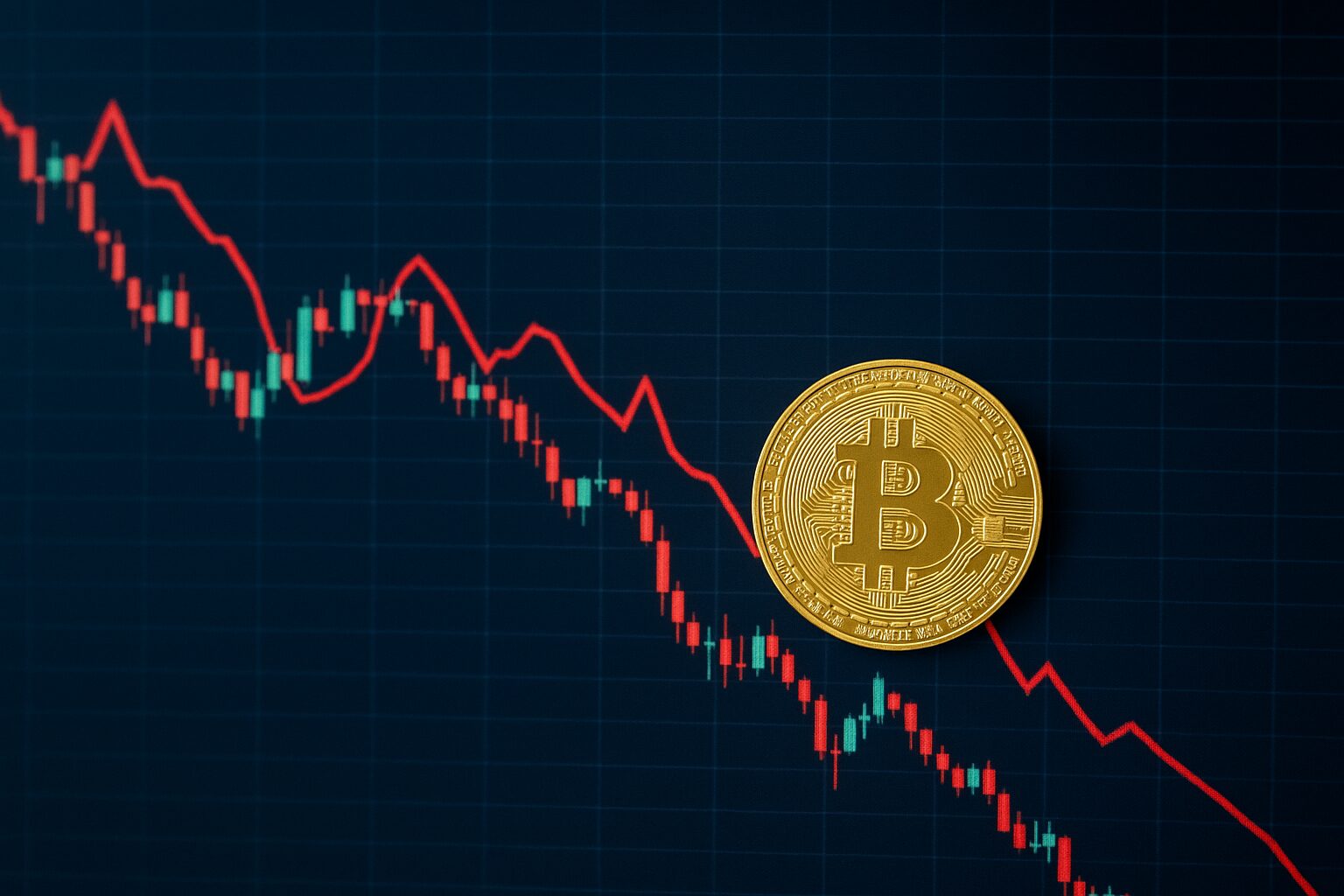If you’ve opened your crypto app recently and noticed your portfolio deep in the red, you’re not alone. The crypto market has been experiencing another wave of massive sell-offs, leaving both new and seasoned investors asking the same question — why is crypto crashing right now?
Cryptocurrencies like Bitcoin, Ethereum, and major altcoins have seen sharp declines in just days. Social media is full of fear and speculation, with traders wondering if this is just another correction or the start of a deeper bear market.
In this article, we’ll break down the key factors behind the current crypto crash, explain how global events and investor psychology play a role, and share what smart investors can do to protect their assets and stay calm during market turmoil.
Understanding Crypto Market Crashes
A crypto crash happens when the prices of major cryptocurrencies fall sharply within a short period — often 20% or more in days or weeks. While volatility is normal in crypto, a crash usually signals a broader loss of confidence.
Market Correction vs. Full-Blown Crash
- Correction: A temporary 10–20% dip after a strong rally, often healthy for the market.
- Crash: A deep, widespread decline caused by panic selling, external pressures, or major news events.
The crypto market is cyclical — it goes through boom and bust cycles, just like traditional financial markets. After every big rally, there’s often a cooldown.
Historical Perspective
- 2018: After Bitcoin’s surge to nearly $20,000, it crashed to around $3,000 during the “ICO bubble burst.”
- 2022: The collapse of Terra/Luna and FTX triggered one of the harshest bear markets, wiping out over $2 trillion in crypto value.
These cycles show that while crashes are painful, they’re not new — and the market has always recovered.
Main Reasons Why Crypto Is Crashing Right Now
Let’s look at the major drivers behind today’s crypto downturn.
1. Global Economic Uncertainty
Inflation remains high in many countries, and central banks like the U.S. Federal Reserve are raising interest rates to control it. This makes borrowing more expensive and reduces investors’ appetite for risky assets like crypto.
When investors move toward safer options like bonds or cash, Bitcoin and other cryptocurrencies tend to fall.
2. Regulatory Pressure
Governments worldwide are tightening their stance on digital assets.
- The SEC continues to pursue cases against crypto exchanges.
- Some countries have introduced strict KYC and tax policies.
These actions create fear among investors and reduce trading volume. Unclear rules make it harder for big institutions to participate confidently in crypto markets.
3. Bitcoin and Ethereum Sell-Offs
Large investors — often called whales — moving or selling their holdings can trigger a cascade of selling.
- Recently, millions in Bitcoin were transferred to exchanges, signaling possible sell pressure.
- When Bitcoin drops, the rest of the market often follows.
This behavior sparks panic among smaller traders, who rush to sell, deepening the fall.
4. Decline in Institutional Support
Institutional investors, who once viewed crypto as the “next big thing,” are becoming more cautious.
When major funds, ETFs, or corporations reduce their crypto exposure, it sends bearish signals to the market.
5. Liquidity Crisis or Exchange Troubles
Exchange issues — such as withdrawal pauses, hacks, or regulatory suspensions — can cause liquidity crises.
When traders can’t access their funds, panic spreads fast. Even rumors of exchange insolvency can trigger a crash.
6. Market Manipulation and Leverage Liquidations
Crypto is famous for high leverage trading. When prices fall slightly, overleveraged traders are forced to sell, causing further drops — a domino effect known as “liquidation cascades.”
Investor Psychology and Fear Factor
Market crashes are not driven by numbers alone — emotions play a massive role.
FUD (Fear, Uncertainty, and Doubt)
FUD spreads quickly in crypto communities. One tweet, rumor, or headline can cause thousands of traders to sell. When fear dominates, logic often disappears.
Panic Selling
When prices drop, inexperienced traders rush to “save” their money — only to sell at a loss. These panic-driven sell-offs accelerate the crash.
The Fear and Greed Index
This popular tool tracks investor sentiment.
- Extreme Greed: Often signals a market top.
- Extreme Fear: Usually happens near the bottom, when recovery may be close.
Impact of Macroeconomic Trends on Crypto
Crypto doesn’t exist in isolation. It’s now tied closely to global finance.
Interest Rate Hikes
When central banks raise interest rates, investors prefer stable, yield-generating assets like bonds over volatile crypto.
Strong U.S. Dollar
A strong dollar usually means weaker Bitcoin. As the dollar gains, investors pull out of risk assets, leading to price declines.
Stock Market Connection
Bitcoin is increasingly correlated with traditional markets like the NASDAQ. When tech stocks fall, Bitcoin often follows.
How Altcoins Are Affected
Altcoins are more volatile than Bitcoin. When Bitcoin sneezes, altcoins catch a cold.
- Low liquidity: Smaller coins crash faster during sell-offs.
- DeFi tokens: Projects relying on liquidity pools face massive outflows.
- NFT and meme coins: These see the biggest declines as speculative interest fades.
For example:
- Solana (SOL) often drops harder than Bitcoin during bear markets.
- Dogecoin (DOGE) and Shiba Inu (SHIB) lose momentum quickly when hype dies down.
These examples show that diversification in crypto must be done carefully.
Historical Perspective: Past Crashes and Recovery
Crashes are painful — but they also reset the market and remove weak projects.
| Year | Event | Impact |
|---|---|---|
| 2013 | Mt. Gox Collapse | Bitcoin dropped over 70% |
| 2018 | ICO Bubble Burst | Thousands of coins vanished |
| 2022 | Terra/Luna & FTX Collapses | $2 trillion wiped from the market |
Despite all this, Bitcoin recovered every time and reached new highs later.
What Investors Should Do During a Crypto Crash
Market crashes can be scary — but they can also be opportunities if approached wisely.
- Stay Calm: Avoid making emotional decisions.
- Reassess Your Portfolio: Focus on strong, utility-driven projects.
- Use Dips Wisely: Consider dollar-cost averaging into blue-chip coins like BTC or ETH.
- Avoid High Leverage: It magnifies losses during volatile times.
- Keep Long-Term Perspective: Crypto adoption is still growing worldwide.
How to Protect Yourself from Future Crashes
You can’t prevent crashes — but you can prepare for them.
- Diversify: Hold a mix of crypto, stablecoins, and non-crypto assets.
- Use Secure Exchanges and Wallets: Avoid platforms with liquidity issues.
- Limit Leverage: Don’t borrow more than you can afford to lose.
- Stay Informed: Follow reliable news, on-chain data, and regulatory updates.
- Set Alerts and Exit Plans: Decide in advance when to take profits or cut losses.
Remember: crypto rewards patience and discipline — not emotion and impulse.
Expert Opinions and Market Outlook
Analysts across major platforms share mixed views on the current crash:
- Glassnode reports that long-term holders are still accumulating despite the downturn.
- Cointelegraph analysts note that Bitcoin’s fundamentals remain strong.
- Bloomberg experts suggest the crash may be part of a normal correction before the next bull cycle.
Looking forward, many predict potential recovery catalysts:
- Bitcoin halving (2026) could tighten supply.
- Spot Bitcoin ETFs may attract institutional investors.
- Regulatory clarity could rebuild confidence in crypto markets.
Conclusion
So, why is crypto crashing right now?
It’s a combination of economic stress, regulatory fears, market psychology, and leveraged trading.
Crashes are part of the crypto journey. Each downturn cleans the market, forcing weak projects out and giving investors time to reassess.
While short-term pain is inevitable, long-term opportunities remain for those who research, diversify, and stay patient
FAQs
1. Why is crypto crashing so hard right now?
Because of global economic uncertainty, higher interest rates, and large sell-offs by major investors.
2. Is this the end of the crypto bull run?
Not necessarily. It could be a temporary correction before the next growth cycle.
3. Will Bitcoin recover from this crash?
History suggests yes — Bitcoin has rebounded after every major crash so far.
4. How long do crypto crashes usually last?
Crashes can last from weeks to months, depending on macroeconomic conditions and investor sentiment.
5. Should I sell or hold during a market crash?
If you’re invested in strong projects, holding may be better than selling in panic. Always reassess fundamentals.
6. Which coins are safest to hold during downturns?
Bitcoin and Ethereum are generally more stable than smaller altcoins.
7. How can I tell when the market is about to rebound?
Look for signs like increasing volume, improving sentiment, and institutional inflows.
Disclaimer
This article is for informational and educational purposes only. It should not be considered financial or investment advice. Cryptocurrency investments carry risk — always do your own research (DYOR) and consult a licensed financial advisor before making any decisions.



